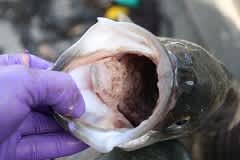Parasites Found on Kentucky’s Lake Cumberland Striped Bass

Fisheries biologists at Lake Cumberland found a parasitic copepod is the cause of unusual sores on the tongue and mouth of striped bass in the lake.
“When we sampled the lake’s striped bass fishery in mid-December, every fish we handled was infested,” said John Williams, southeastern district fishery biologist for the Kentucky Department of Fish and Wildlife Resources.
The copepod, genus Achtheres, has been found in recent years in mountain lakes in Arkansas, North Carolina, Tennessee and Virginia.
“The parasites infest the fish’s oral cavity and do not affect the fish’s flesh. The fish are okay to eat,” said Williams.
The external parasites are visible to the naked eye. Young copepods attach to the fish’s gill filaments and migrate to its mouth as adults to reproduce. The parasites can impact the gills and hamper respiration in larger fish.
It’s uncertain at this time if the parasite is native to the region or has somehow been introduced. Angler transfer of fish through livewells and the introductions of infected fish may have enabled the parasite to spread so quickly from lake to lake in the region.
Williams said the parasites have also been found on a small percentage of largemouth bass in three reservoirs in south central Kentucky: Wood Creek Lake, Laurel River Lake and Cedar Creek Lake.
“Fish get a variety of parasites. They are an annoyance,” said Williams. “They would not be the primary cause of a die-off of stripers in Lake Cumberland.”
Another mystery is why the parasite spread so rapidly through the population. “We suspect the lowering of body condition has made striped bass more susceptible to the parasites,” said Williams.
Lake Cumberland, a 50,250-acre major reservoir near Jamestown, Ky., is the state’s premier striped bass fishery and has supported a quality population of stripers since the 1980s.
In 2007, Lake Cumberland was drawn down about 40 feet below summer pool to make repairs to Wolf Creek Dam. Since that time, the body condition of striped bass in the lake has been impacted due to the loss of cool water habitat in the fall.
“Growth rates have declined considerably. In the past, it took striped bass in Lake Cumberland three years to reach the keeper size of 24 inches. Now, we have a majority of fish stockpiling below that length,” said Williams. “We believe all this is due to conditions that are stressing fish. They’re not eating and are not growing as fast.”
However, Williams said the stomachs of striped bass recently sampled were full. “In December, the stripers were up in the creeks gorging on small shad. By all indications, there was a good shad spawn last spring,” he said.
An ecological study funded by Virginia’s Department of Game and Inland Fisheries found that a number of lakes in the region with populations of striped bass have been affected as early as 2000.
The parasites were first identified on striped bass in the Potomac River in 1915. A study in the 1950s in Louisiana found the parasite on black bass, bullheads and other sport fish species.
Recent research suggests that two species may exist in lakes in the southeastern United States, but the impact of infestations is poorly understood. Researchers found that the abundance of the parasites is seasonal and cyclic and often reflects the overall condition of the host.

